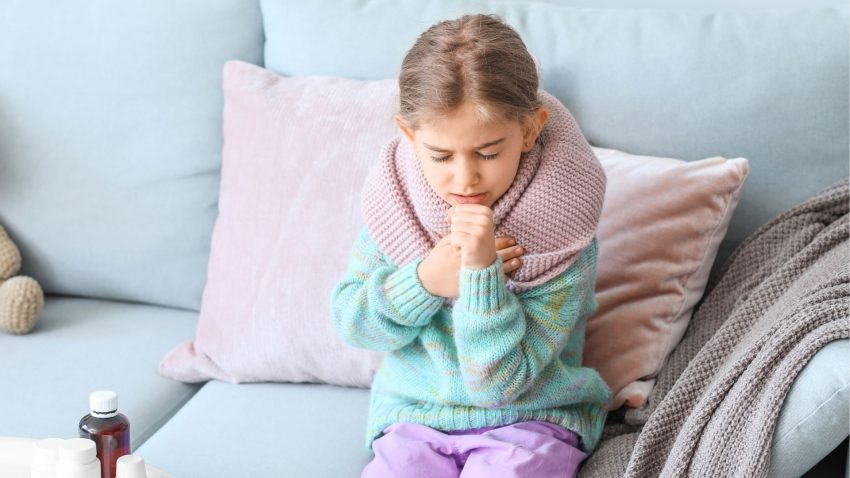Whooping cough, also known as pertussis, is a highly contagious respiratory infection that can be especially dangerous for children. While it may begin with symptoms that resemble a common cold, the disease can quickly develop into severe coughing fits that affect breathing, feeding, and overall health. Understanding whooping cough and its impact on children is essential for parents, caregivers, and communities working to protect young lives.
What Is Whooping Cough?
Whooping cough is caused by the bacterium Bordetella pertussis. The infection spreads easily through coughing, sneezing, or close contact with someone who is already infected. Its nickname comes from the distinctive “whooping” sound some people make when gasping for air after intense coughing episodes. While this sound is more commonly heard in children, especially infants, the infection can affect people of all ages.
How Whooping Cough Affects Children
Early Symptoms
In the beginning, whooping cough may look like a mild cold. Children often develop a runny nose, sneezing, mild fever, and occasional cough. Because these symptoms are not specific, it can be difficult for parents to recognize the disease early on.
Progression of Symptoms
After about one to two weeks, the cough becomes more severe. Children may experience:
- Repeated, uncontrollable coughing fits
- A high-pitched “whoop” sound when breathing in after a coughing episode
- Vomiting after coughing
- Difficulty eating, drinking, or sleeping due to coughing
For infants under six months, the illness can be even more serious. Instead of the typical “whoop,” they may experience pauses in breathing (apnea), which is a medical emergency.
Complications in Children
Whooping cough can lead to several complications, especially in babies and toddlers whose immune systems are not fully developed. Some of the most common complications include:
- Pneumonia
- Seizures
- Dehydration from frequent vomiting
- Weight loss due to difficulty feeding
- Hospitalization for severe breathing problems
In rare but severe cases, whooping cough can be life-threatening, particularly in infants who are too young to be fully vaccinated.
Why Whooping Cough Is Dangerous for Infants
Infants are the most vulnerable group because they have limited immunity and smaller airways. According to health experts, most whooping cough-related deaths occur in babies under six months of age. Their bodies cannot handle the intense coughing and lack of oxygen as well as older children or adults. This makes prevention through vaccination and community awareness especially important.
How Whooping Cough Spreads
Whooping cough is highly contagious. A child with the infection can spread it to others by coughing or sneezing near them. The bacteria travel in tiny droplets through the air and can infect anyone who inhales them. Because the early stage of whooping cough looks like a regular cold, many people do not realize they are contagious until the illness becomes more severe.
Diagnosis and Treatment
Medical Diagnosis
Doctors typically diagnose whooping cough based on symptoms, physical examination, and sometimes lab tests such as nose or throat swabs. Early diagnosis is critical because treatment works best in the initial stages of infection.
Treatment Options
Treatment usually involves antibiotics to reduce the severity of the illness and prevent spreading it to others. For children, especially infants, hospitalization may be necessary to monitor breathing, provide oxygen, or ensure proper nutrition. Supportive care, including rest, fluids, and small frequent meals, can also help manage symptoms.
The Role of Vaccination
Vaccination is the most effective way to prevent whooping cough. Children usually receive the DTaP vaccine, which protects against diphtheria, tetanus, and pertussis. The vaccination schedule begins at two months of age and requires several booster doses throughout childhood. Pregnant women are also advised to receive a pertussis vaccine during the third trimester to provide their newborns with protective antibodies before they are old enough for their first dose.
Herd immunity, where a high percentage of the community is vaccinated, plays a key role in protecting babies who are too young to be fully immunized. This highlights the importance of both individual and community responsibility in disease prevention.
Supporting a Child With Whooping Cough
Parents and caregivers play a crucial role in helping a child recover from whooping cough. Some practical steps include:
- Keeping the child hydrated with water or breast milk
- Offering small, frequent meals to prevent vomiting from coughing
- Using a humidifier to soothe irritated airways
- Keeping the environment calm, since excitement can trigger coughing fits
- Following all medical instructions carefully and completing antibiotic treatment
Children should be kept home from school or daycare until they are no longer contagious, usually after taking antibiotics for at least five days.
Long-Term Impact on Children
Most children recover fully from whooping cough, but the illness can be exhausting and disruptive. The coughing fits may last for weeks or even months, leading to what is sometimes called the “100-day cough.” During this time, children may feel tired, miss school, and struggle to regain normal routines. Families also face emotional and financial stress when a child requires hospitalization or long-term care.
Raising Awareness and Protecting Children
Whooping cough remains a global health concern despite the availability of vaccines. Outbreaks still occur in areas where vaccination rates are low or when booster shots are missed. Educating parents about the importance of timely vaccination, early recognition of symptoms, and prompt medical care can save lives. Communities, schools, and healthcare providers all share responsibility for protecting children from this preventable disease.
Safeguarding Childhood Health
Whooping cough is more than just a persistent cough. For children, especially infants, it can be a serious and sometimes life-threatening illness. While medical treatment helps manage symptoms, prevention through vaccination remains the strongest shield. By staying informed, ensuring children are fully vaccinated, and recognizing symptoms early, parents and caregivers can protect their loved ones and help safeguard community health.
